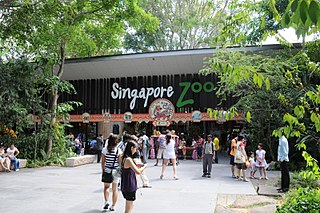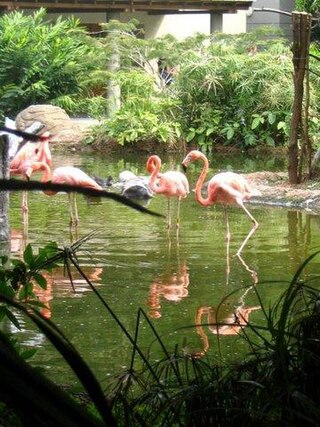
Bristol Zoo was a zoo in the city of Bristol in South West England. The zoo's stated mission was to "maintain and defend" biodiversity through breeding endangered species, conserving threatened species and habitats and promoting a wider understanding of the natural world".

Marwell Zoo is a 140-acre (57 ha) zoo situated in Colden Common near Winchester, in the English county of Hampshire. It is owned and run by the registered charity Marwell Wildlife. The zoo is home to 1,208 animals of 149 species. The charity undertakes a range of educational and conservation activities, with a particular focus on Africa in addition to work from its base.

Twycross Zoo is a medium to large zoo near Norton Juxta Twycross, Leicestershire. The zoo has the largest collection of monkeys and apes in the Western World, and in 2006 re-launched itself as "Twycross Zoo – The World Primate Centre".

The Singapore Zoo, formerly known as the Singapore Zoological Gardens or Mandai Zoo, is a 28 hectares zoo located on the margins of Upper Seletar Reservoir within Singapore's heavily forested central catchment area. It is operated by the Mandai Wildlife Group, which also manages the neighbouring Night Safari, River Wonders, Bird Paradise as well as the forthcoming Rainforest Wild Park.

The Philadelphia Zoo is a zoo located in the Centennial District of Philadelphia on the west bank of the Schuylkill River. It was the first true zoo in the United States; it was chartered by the Commonwealth of Pennsylvania on March 21, 1859, but its opening was delayed by the Civil War until July 1, 1874. The zoo opened with 1,000 animals and an admission price of 25 cents. For a brief time, the zoo also housed animals brought to U.S. from safaris by the Smithsonian Institution, which had not yet built its National Zoo.

The Staten Island Zoo is an 8-acre (3.2 ha) urban zoo in West New Brighton, Staten Island, New York City. The zoo is open year-round except on Thanksgiving, Christmas, and New Year's Day. It has been accredited by the Association of Zoos and Aquariums (AZA) since 1988.

Melbourne Zoo is a zoo in Melbourne, Australia. It is located within Royal Park in Parkville, approximately 4 kilometres (2.5 mi) north of the centre of Melbourne. It is the primary zoo serving Melbourne. As of 2021, the zoo contains 3742 animals comprising 243 species, from Australia and around the world. The zoo is accessible via Royal Park station on the Upfield railway line, and is also accessible via tram routes 58 and 19, as well as by bicycle on the Capital City Trail. Bicycles are not allowed inside the zoo itself.

Werribee Open Range Zoo is an African themed zoo in Werribee, about 32 kilometres (20 mi) south-west of Melbourne, Victoria, Australia. It is part of the Zoological Parks and Gardens Board or Zoos Victoria, which also includes Melbourne Zoo, Kyabram Fauna Park, and Healesville Sanctuary. It is situated on approximately 225 hectares and is located on the Werribee River in Werribee Park, adjacent to the Werribee Park Mansion. It was originally agistment land to the Melbourne Zoo. Werribee Open Range Zoo is home to 360 animals of 40 species as of 2021.

The inland taipan, also commonly known as the western taipan, small-scaled snake, or fierce snake, is a species of extremely venomous snake in the family Elapidae. The species is endemic to semiarid regions of central east Australia. Aboriginal Australians living in those regions named the snake dandarabilla. It was formally described by Frederick McCoy in 1879 and then by William John Macleay in 1882, but for the next 90 years, it was a mystery to the scientific community; no further specimens were found, and virtually nothing was added to the knowledge of this species until its rediscovery in 1972.

David Howells Fleay was an Australian scientist and biologist who pioneered the captive breeding of endangered species, and was the first person to breed the platypus in captivity.

Australia Zoo is a 700-acre (280 ha) zoo in the Australian state of Queensland on the Sunshine Coast near Beerwah/Glass House Mountains. It is a member of the Zoo and Aquarium Association (ZAA), and is owned by Terri Irwin, the widow of Steve Irwin, whose wildlife documentary series The Crocodile Hunter and his family's new show Crikey! It's the Irwins made the zoo a popular tourist attraction.

Adelaide Zoo is a zoo in Adelaide, Australia. It is the country's second oldest zoo opening in 1883, and is operated on a non-profit basis. It is located in the parklands just north of the city centre of Adelaide, South Australia. It is administered by the Royal Zoological Society of South Australia Incorporated, which is a full institutional member of the Zoo and Aquarium Association and the World Association of Zoos and Aquariums, and which also administers the Monarto Safari Park near Murray Bridge.

ABQ BioPark Zoo, located in Albuquerque, New Mexico, is a facility of the Albuquerque Biological Park. Founded in 1927, the 64-acre (26 ha) zoo was originally known as the Rio Grande Zoo. Sections of the zoo include an Africa exhibit area, an Australia exhibit area, the "Cat Walk" and a herpetology area. An endangered species carousel was added in 2016. A narrow-gauge railroad connects the zoo to the other facilities of the Albuquerque Biological Park. Walking distance through the zoo is 2.27 miles (3.65 km).

The Taipei Zoo, sometimes referred to as the Muzha Zoo, is a public zoological garden in Wenshan District, Taipei, Taiwan. It is the most famous zoological garden in Taiwan and a leader in conservation, research and education, and recreation. It is one of the largest zoos in Asia, with a total area of 165 hectares, of which more than 90 ha are developed.

The Australian Reptile Park is located at Somersby on the Central Coast of New South Wales, Australia. It is about 71 kilometres (44 mi) north of Sydney, and is just off the M1 Pacific Motorway, near Gosford. The Park has one of the largest reptile collections in Australia, with close to 50 species on display. The wide variety of reptile species at the Park includes snakes, lizards, turtles, tortoises, tuataras, American alligators and crocodiles.

Sydney Zoo is a zoo in Bungarribee in the Western Sydney Parklands, in Greater Western Sydney, New South Wales, Australia. Sydney Zoo is located 38 kilometres (24 mi) west of the Sydney central business district. It occupies a 16.5-hectare (41-acre) site. Sydney Zoo is a member of the Zoos and Aquariums Association of Australia and New Zealand.

Cali Zoo is located in the city of Cali in the country of Colombia. The Zoo belongs to a foundation that carries its name and whose mission, since it took the zoo's administration in 1981, has been to improve the animals' diet, their natural environment, and the medical care of the existing fauna.

Tasmania Zoo is a zoo located in Launceston, in the Australian state of Tasmania. Situated on 900 acres (360 ha) of old growth native bushland, it is home to the state's largest collection of native and exotic animals. Tasmania Zoo is a fully accredited member of the Zoo and Aquarium Association, working closely with all Australasian zoos, and are involved in various species management programs.

The Karlsruhe Zoo is a city garden with a zoo in the southwest of Karlsruhe, Germany. It also encompasses the outer area; Tierpark Oberwald in the southeast of the city. The main area totals 22 hectares, and the Oberwald Zoo has an area of 16 hectares. A total of around 3000 animals of over 240 species live at the Zoologische Stadtgarten Karlsruhe. The city garden is located north of the Karlsruhe Hauptbahnhof and south of the Karlsruhe Congress between the Karlsruhe districts of Südstadt and Südweststadt. The zoo was opened in 1865, making it one of the oldest zoos in Germany. The city garden and zoo form a common, enclosed area and cannot be visited separately.

Australia Walkabout Wildlife Park is a wildlife sanctuary located in Calga, New South Wales, Australia. The wildlife park is home to Australian native birds, mammals and reptiles as well as farm animals. It offers research and education programs, with visitors able to undertake day and night tours. The park is home to a wide range of Australian animals and in 2021 became home to a group of meerkats, the park's first exotic animals.



















